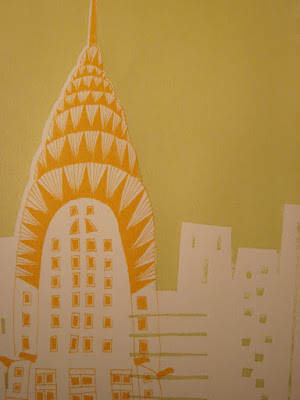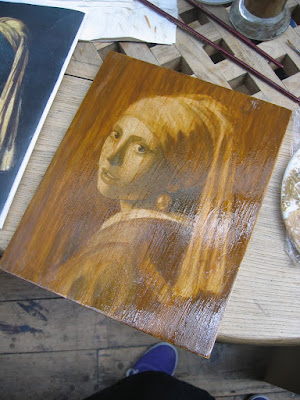




SCREEN PRINTING METHOD
This is more the screen printing method I had in mind as this is more versatile, can do really intricate details - basically if you can get it as a black and white image you can print it - but the main problem is it can not be done at home! I absolutely love this process though and have got a few projects in mind so will come back and do more.
Basically the idea is to use the photo exposure unit to 'print' the image onto the screen mesh, and it will do what the newsprint does, except the black lines will be where the color will print through.
1) First have the image in acetate, or good quality paper. A strong black and white image is good.
2) Prepare the screen with a screen emulsion ( light sensitive, to be applied in a room with no daylight). Use gloves. The emulsion is a blue green colour. It comes in yellow and a blue tins to be mixed together.
3) Put the emulsion in an emulsion trough, the screen mesh at an angle, and pushing the trough against the screen and lightly tip it, moving from bottom up, to put a shiny coat of emulsion on the screen. Wipe away excess emulsion at the edges.
4) Wait for the emulsion to dry, takes 30 mins, or 5 mins with a hair dryer.
5) Put the image the way you want it to be viewed, put the frame down on the exposure unit, follow timing and instruction as required.
6) Afterwards, take it to the wash room and use water to wash away the emulsion, you should see you image emerge. Spray the water gently in the beginning and more later. Wash both sides.
7) Blot each side with newsprint to get rid of excessive water, blow dry and ready for printing.
8) See stencilling process for the printing - same.
9) Once finish scrub the screen with a brush and cleaning agent, then use high water pressure gun to clean. remember to wear gloves, goggles, breathing mask and for me very important - ear protections! ( I forgot and my ears rung for a while)
TIPS:
a) If not using the acetate or translucent paper for the image then use a good photocopy or print on good paper and apply vegetable oil back and front to make it translucent. Blot away excessive oil.lack and white image you can print it
b) Think about the positive and negative side of the final prints!
c) exposed image can stay on the screen for years if need be!








































